#buffy rewatch 2k20
Photo





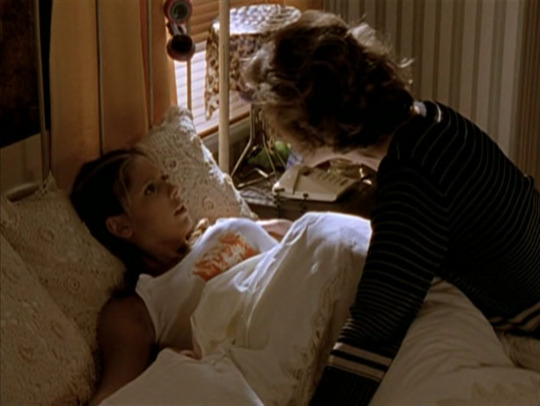
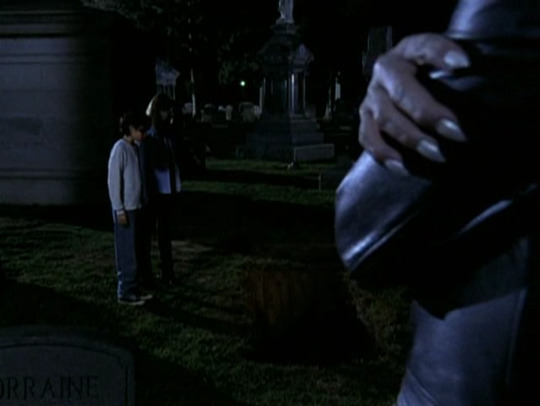


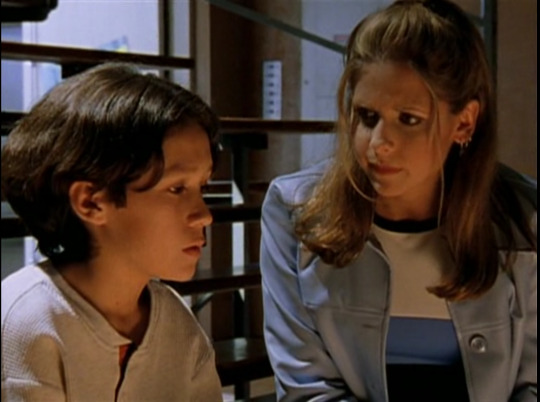
Intergenerational encounters in Nightmares (Buffy 1x10)
2 notes
·
View notes
Photo


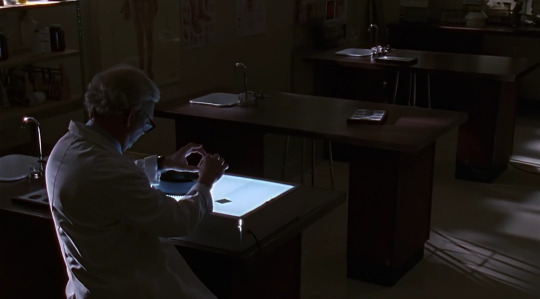



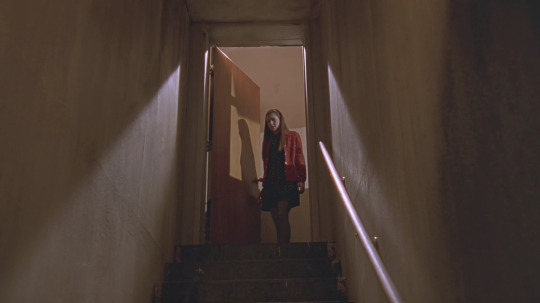

Recreation of my previous photoset, using the remastered footage of season 1
Buffy season one imagery series: high school is hell
#i decided to recreate my previous visual language post with screengrabs from the remastered series#and it's interesting to see what changed#and what remained the same#the shadows are still generally the same for some of them particularly teacher's pet nightmares and the witch#but everything is so much more visible and not in a good way#all the tension from the i robot you jane image has completely disappeared#the contrast between the bright blue computer screens and the dark room has completely vanished#and i think this shows that even with the shoestring budget of season 1 the directors were really careful to give the show a certain style#that has been mostly removed from the remaster#and its so sad that the shots with buffy and willow in complete darkness have been brightened to show them in the remaster#on the one hand we can identify with them more but on another the mystery and uncertainty of their experiences is completely excised#btvs#buffy the vampire slayer#visual language series#season one imagery series#buffy rewatch 2k19#buffy rewatch 2k20#credits to impalementation for the format#everything is so bright in these images!!!#i hate it!!!#long post#long post tw#tw long post#and all the tight shots have been expanded which removes all the claustrophobia and creepiness#it really just looks like someone held the film reel up to sunlight and washed everything distinctive out
0 notes
Photo
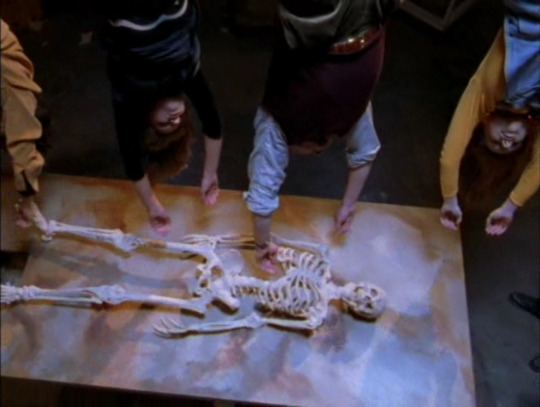





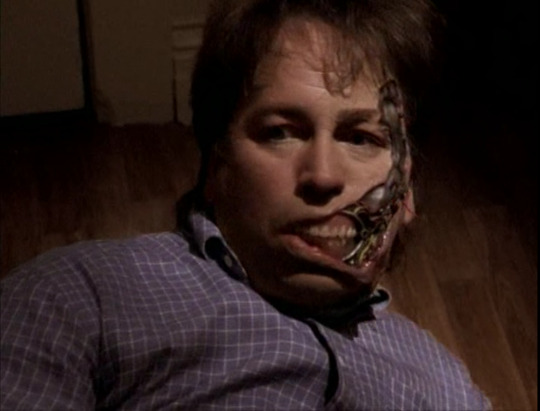

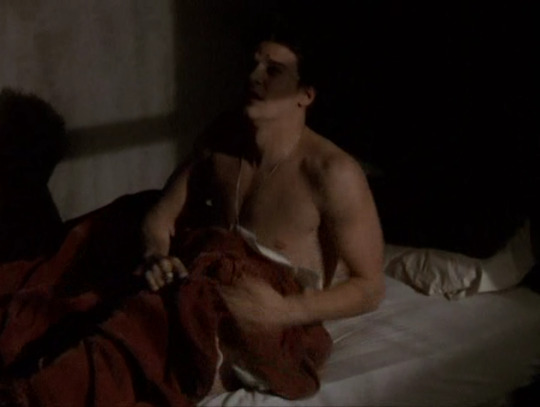

buffy season two imagery series: revivification
Buffy: They're gonna bring him back. They're gonna bring the Master back to life, and I seem to recall you telling me he was history.
Giles: Buffy, I-I-I've never heard of a-a revivification ritual being successful.
Eric: I tried to tell him. If you take a life in order to make a life, the whole thing is a wash. No harm, no foul.
Xander: Yeah, but you did. You gave up your life.
Buffy: I had you to bring me back.
Buffy: You died.
Ted: That's right, little lady, you killed me. Do we have something to say about that? Are we sorry?
Giles: Oh, good Lord! You were dead, Buffy.
Buffy: I was only gone for a minute.
Angelus: I *am* Angel. At last.
...
Angelus: Dream on, schoolgirl. Your boyfriend is dead.
The first half of season two of Buffy the Vampire Slayer has a consistent theme of creatures being awakened and reawakened. Where Season 1′s take on vampirism focused on the old draining the young, season 2 focuses on the revivified body as vampiric, a metaphor for arrested development and an inability to let go of the past.
This of course starts with Buffy’s death at the end of season 1 and her subsequent revivification, a motif that is repeated throughout the first half of the season 1. Buffy’s traumatic revivification leads to the spectre of The Master and the possibility of his own resurrection haunting the opening of the season, When She Was Bad, and is echoed once more in Inca Mummy Girl, when a young girl sacrificed for the greater good is given another chance at life, similar to Buffy’s own experience. Ampata, like Daryl from Some Assembly Required, in her desperation to recapture a life she felt denied to her, starts to feed on others to sustain her corpse’s performance of life, selfishly denying others that which was denied to her.
In Ted, The Dark Age, and I Only Have Eyes For You, long dead people relive experiences of trauma over and over, dying each time just to be reanimated in a grotesque hell. They too exhaust bodies around them to maintain their own parody of living, unable to escape the moment of trauma that defined their deaths. The main villains of the season also orbit around revivification - Spike enters town to revitalize Drusilla, who in turn seeks to reawaken The Judge. The season arc takes form as Angelus is reawakened, and he ultimately plots to reawaken Acathla. At every turn of the season, both ancient and freshly deceased horrors are brought back to life to haunt our characters, seeking to trap them in a prior stage of development, preventing them from growing and maturing. As they represent cycles of arrested growth, they threaten our own characters in a similar cycle of death, revival, and death again. Buffy ends the season by breaking the cycle, definitively casting a newly-revived Angel out of Sunnydale and out of her life decisively.
#season two imagery series#buffy season two imagery series#btvs#buffy the vampire slayer#btvs rewatch 2k20
32 notes
·
View notes
Text
Some Notes on Out of Mind, Out of Sight
I’ve kind of abandoned writing episode reviews and moved towards shorter hot takes exploring specific questions, but I realized this was still sitting in my drafts, so I’ve touched it up and added some clarifying bits:
On theme vs character and misreadings:
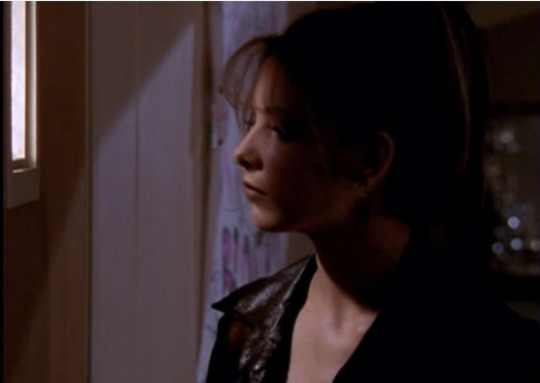
- This is one of the first episodes that uses its central metaphors to comment on the characters, rather than simply high school itself. This narrative shift started in Nightmares, which sought to explore the characters’ psychologies by way of literalizing their fears, but unfortunately did nothing really to tell us anything about them. Instead, this episode claims to be telling us a story about what it’s like to be ignored in high school, but truthfully uses this metaphor to comment on the isolation felt by several characters, particularly Cordelia, opening up her character for exploration and growth, previously inaccessible to her. Unlike episodes like The Witch, Teacher’s Pet, or The Pack, the central metaphor here is not about An Issue as it is about A Character - characters don’t drive the exploration of a theme, but theme is used to drive the exploration of character. Herein lies the path season 2 will take up.
- In fact, this episode isn’t so much about invisibility as it is about misreading, misdirecting, and misperceiving - the clues are pointed to us by Marcie’s messages: Look. Listen. Learn. Buffy and Cordelia haven’t “seen” each other all semester, and the episode starts with them misreading each other once again - Buffy is a freak, Cordelia is a snob. By the end of the episode, they begin to see each other more clearly, and have a better understanding of where the other stands.
- It is appropriate that the episode begins its exploration of Cordelia’s character in an English class - Cordelia reads Merchant of Venice in an unexpected way, and her odd yet surprisingly interesting reading of the text kicks off our own re-reading of Cordelia; this is the scene that first tells us there’s more to her than meets the eye, the first time the show actively encourages us to read her as a complex person. We are shown that Cordelia has been invisible to the audience this whole time, and the show is in the process of making her visible and legible to us. We are told that we were wrong to read her as a stereotype, and the gaps in our reading are filled in over the episode’s course.
- This episode feels like a forerunner of Earshot. The idea that the most popular and the least popular struggle with the same anxieties and loneliness will be explored once again then, once the school has been developed into a much more believable and well-trodden ecosystem. At this point, Marcie means much less to us than Jonathan, so it works slightly less well here, but it’s still a valiant attempt and a necessary one to shift the show’s narrative gears.
19 notes
·
View notes
Text
Prophecy Girl: Four Readings of Buffy’s return
Prophecy Girl is a turning point for the show - morgue argues that this is where the show’s commitment to real emotion and real threat collide, creating a situation where real change can emerge. Here, every character begins shifting in sizable ways: the love triangle is on its way out, Cordelia and Ms Calendar are integrated into the group, the Master dies, Buffy chooses to be the Slayer, and Giles affirms himself as her Watcher. CriticallyTouched’s review of this episode focuses on its theme of sacrifice. Personally, it seems to me like the episode is most remembered for two scenes: Buffy’s monologue to Giles and Buffy’s rejection of Xander. In this piece though, I wanna think through the subversion of Buffy’s fate, and what that means for the show:
Four readings of Buffy’s resuscitation:
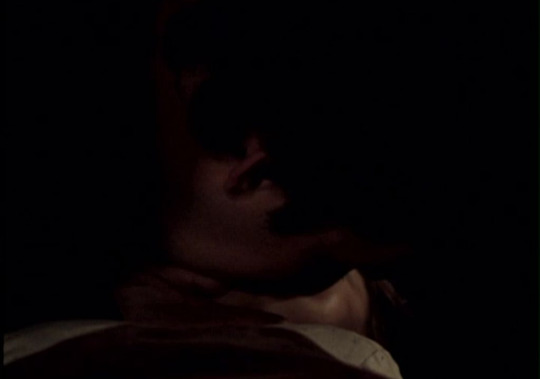
- Buffy’s resuscitation is about Buffy. It is about her willingness to sacrifice herself and take responsibility for the duties she owes to the world. It is her courage and her willingness to see her Slayerhood through that metaphorically allows her to take the next step into adulthood. (Reading the Slayer as a metaphor for adulthood) Her resuscitation is a reward for true sacrifice and her pure heart. Her acceptance of her fate regardless of how bad her choice is makes her a morally pure character, and paves the way for the moral critique the show makes of characters like Ampata, Ford, and characters that seek to prolong their life at the expense of others - namely, vampires. She becomes the Slayer here.
- Buffy’s resuscitation is about the networks of power she has built. The resuscitation is about how she is not a normal Slayer, but one who actively rejects the concentration of power in one person’s hands. Throughout the season, she has built a core group of allies who are able to intervene when she needs their help the most. Her rejection of the Slayer mythos allows her to rewrite the mythos beginning here - she rewrites the titular Prophecy. Prophecy Girl, then, is not about the way she is bound to a prophecy but about Buffy actively challenging and rewriting prophecy. The episode is about Buffy’s rejection of the Slayer story as is traditionally understood, giving her room to own it, shape it, and imbue it with her own morality over the next six seasons. This is where “A Slayer with family and friends” starts - where “you’ve got ties that keep you here” starts - where the empowerment of all Slayers in season seven starts.
- Buffy’s resuscitation is about Xander. While it is tempting to read the episode being about the networks of power Buffy has built, that’s not actually what the episode demonstrates. Buffy truly has no active role in rewriting her story - she goes to her death fully believing she’ll die. There’s no agency here. She doesn’t plan a way around it, she doesn’t anticipate a solution. She chooses to die. To fulfil the Slayer legacy. That’s what makes the first reading so powerful. Instead, her resuscitation is about Xander’s growth - Xander’s willingness to be a hero even with no hope of romantic conquest, a stepping stone for his growth. Buffy’s own growth in the episode ends when she decides to face the Master. Her resuscitation is all about Xander. In fact, the entire episode is much more about Xander than it is about Buffy. The episode starts from Xander’s perspective and follows him a hell lot more than it follows Buffy. One of the emotional touchstones of the episode is Buffy rejecting Xander, after all - this episode is the beginning of Xander’s path to maturity. It’s not about networks of power because Angel, Giles, Willow, Cordelia, and Ms Calendar actually play little role in bringing Buffy back to life. This interpretation is picked up in the thread @impalementation and I explored in our discussion of Buffy’s sexy dance with Xander in When She Was Bad.
- Buffy’s resuscitation is about Buffy the Vampire Slayer. It’s not about Buffy rewriting the rules of the narrative. It’s not about Xander’s coming into his own as a hero. It’s not about Buffy rejecting the power structures of the Slayer narrative. It’s about the show challenging itself and pushing the show’s original vision - a blonde girl on the run from a vampire, but it’s the vampire who’s in danger. After Xander’s opening scene, the show faithfully plays out this scene. The original vision for the show is complete. Now what? Killing Buffy and bringing her back allows the show to re-position the Slayer prophecy as not just empowering, but oppressive in its own way. It is not enough to simply give one girl all this power. The girl has to be able to question and challenge this power, and rewrite it in her own words. The show has to demonstrate it is willing to do that. To question and rebuke its own mythos. Buffy herself can’t do that yet. But the show starts to here. And soon, Buffy herself will. This is the show staking a claim to legacy here, a promise to challenge story and myth, even when story and myth seem to be empowering.
#btvs#buffy the vampire slayer#btvs rewatch 2k20#prophecy girl#im done talking about this episode i swear#maybe i'll skip over when she was bad#idk maybe#i might still write smth about it
14 notes
·
View notes
Text
On Willow’s character arc from Inca Mummy Girl to Halloween
I’m fascinated by how Willow has actually had the least amount of character episodes as of Halloween (barring Giles) - counting Halloween as a character episode for everyone, given the way it splits attention pretty evenly to everybody’s issues. How does Willow become such an important character in the show, when right now she barely seems to feature?
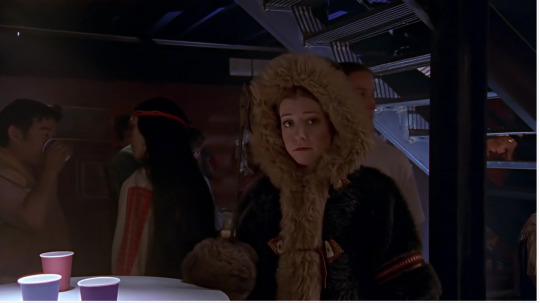
As of now, these are the character episodes (counting character episodes as episodes that put a lead character at the epicentre of the plot, or episodes that take the viewpoint of a character other than Buffy)
Cordelia: Out of Mind, Out of Sight; Reptile Boy; (Some Assembly Required)
Xander: Teacher’s Pet; The Pack; (Prophecy Girl); Inca Mummy Girl
Willow: I Robot, You Jane….?
At the early stages of the show, Xander is somewhat the deuteragonist, as the natural foil for Buffy. His character gives the show a way into the social world of high school as experienced by men, and his episodes are very much about these issues. Cordelia also functions as a foil for Buffy, and her episodes drag Buffy into the world of the rich, the popular, and the unfettered - they both function as access points into other social worlds Buffy and Willow might not be privy to on their own.
As a result, the one time a Willow episode was done, in which the character was used to give insight into the world of the nerds (I Robot, You Jane), that fell apart because the Scoobies are already nerds, so any portrayal of other nerds easily risks falling into absurd caricature. Willow doesn’t offer a neat contrast to Buffy the way Xander or Cordelia do, and so she’s often left to be supporting player rather than at the forefront of story.
And yet, over the course of the past three episodes, the writers have figured out how to make Willow a dynamic character by giving her more to do in the B-plot, and by threading a systematic, intentional growth over the season instead of by giving her big character episodes. (To my memory, Halloween and Phases are the closest things to Willow-centric episodes this season, and even then it’s shared).
In Inca Mummy Girl, Willow decides to try moving on from Xander. This episode is also the first time Oz notices her before meeting her, while she’s in her Inuit costume (problematic!). This moment has been an oft-played card thus far - Willow looking in from the outside (happens in Welcome to the Hellmouth, Prophecy Girl, and When She Was Bad). This is the last time the show will hit this beat, and is a nice way of reminding the viewers of where she is.

In Reptile Boy, Willow helps Buffy sneaks around and then calls out Giles and Angel for treating Buffy badly - her first time snapping at anyone on the show! Here, her moral code and sense of righteousness is blooming, and she is becoming more confident in her views.

In Halloween, this assertiveness is brought to the fore once more as she’s put in the position of taking charge and leading the group, while wearing a sexy ghost costume. She becomes a more adept leader and more comfortable in her own skin - though it’s important to note she does revert to her normal dress next episode! The experience in the costume does not magically change her, but is instead a way for her to realize that she can be multiple versions of herself, and arguably is what leads to her stronger experimentation with fashion over the next few seasons. (Not that Willow-style wasn’t already amazing). This is the last time Oz notices her before What’s My Line - her growth in the early season is complete, and she is about to take her next steps with her meeting Oz. The threading of Oz not only counterpoints her growth here, but is a great way of setting up her future growth seamlessly.

Arguably, this mini character arc and these small moments of character growth and development is what makes Buffy season 2 so damn good, and what makes Willow have the longevity to surpass Xander as deuteragonist by season 3. Even as Xander and Cordelia serve as good foils, being foils makes it difficult for the writers to push them in any one direction (and risk losing their storytelling capacity). They do grow and change, but they become nowhere near as dynamic as Willow does (until Cordelia leaves BtVS, where she has a stronger chance to exist outside of being a foil). Willow doesn’t serve a neat gateway or niche into other high school worlds, and so by necessity the writers have to give her more to do beyond just being a nerd. It is this choice that propels her into being one of the most well-written and developed characters in the Buffyverse.
#btvs#buffy the vampire slayer#willow rosenberg#btvs rewatch 2k20#inca mummy girl#reptile boy#halloween
16 notes
·
View notes
Photo
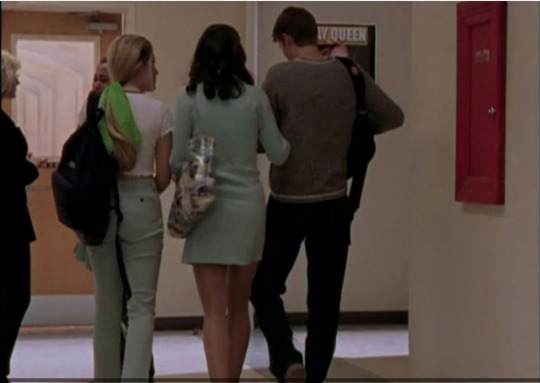

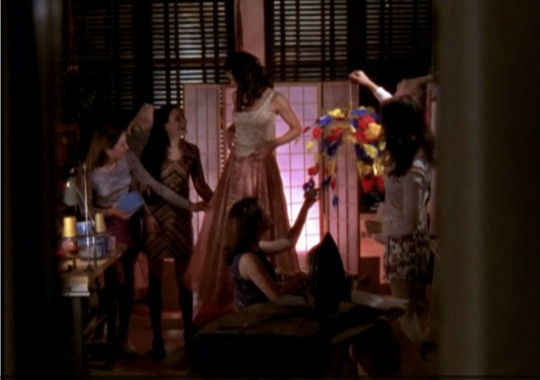
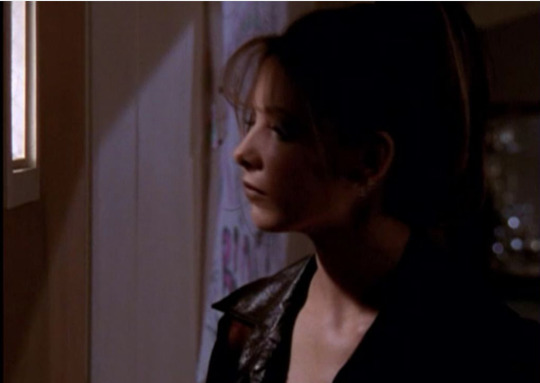
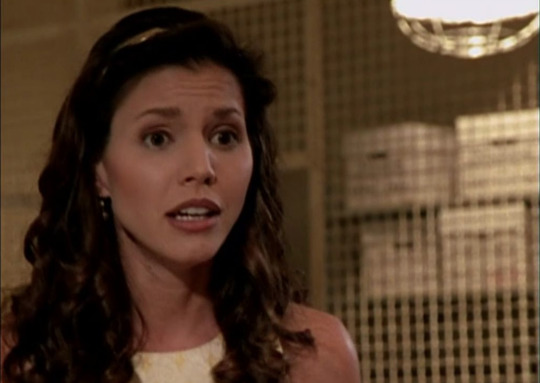
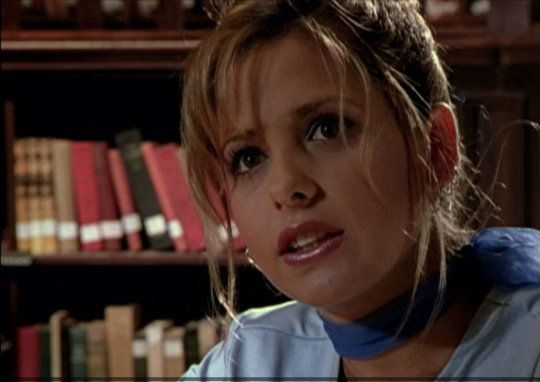
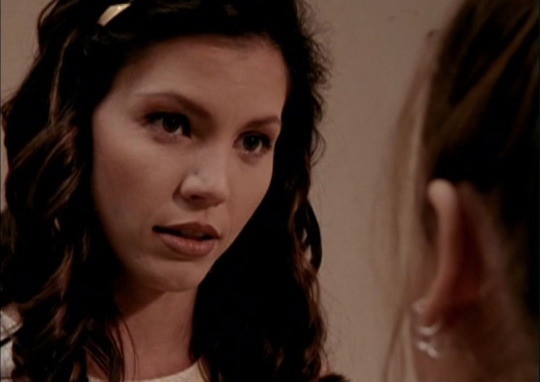


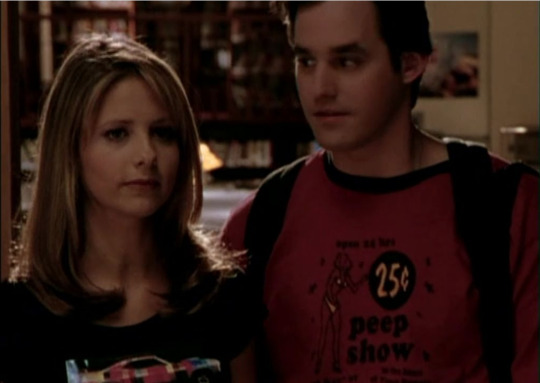
Cordelia and Buffy learning to read each other in Out of Mind, Out of Sight:
The episode begins with Buffy peering at Cordelia from afar, Cordelia framed by wide shots and Buffy framed in close ups/mid shots. Cordelia is unreadable and untouchable, a veneer of strength and pride. The shots close in when Cordelia comes to Buffy, Buffy in her place of power and control at the library - Buffy is seated and framed up close, looking up disbelievingly at Cordelia who begs for her help. She cautiously and dismissively looks at Cordelia, Cordelia still played for humour to the audience. By the time they have their heart to heart, the camera treats them both with close ups, both characters finally relating to each other and Cordelia finally accessible to the audience as a character in her own right. The final shots of them looking at each other have them framed by the people in their lives - while they can finally read each other, their social worlds remain oblivious to the other. Xander and Mitch are pointedly not looking at Cordelia and Buffy respectively, refusing to read or address the other. In turn, the shaky connection between Buffy and Cordelia is rejected for now (but not for long).
#btvs#buffy the vampire slayer#out of mind out of sight#btvs rewatch 2k20#also I realize this imageset makes a compelling case for Buffy/Cordelia#an interpretation I am completely okay with
13 notes
·
View notes
Photo

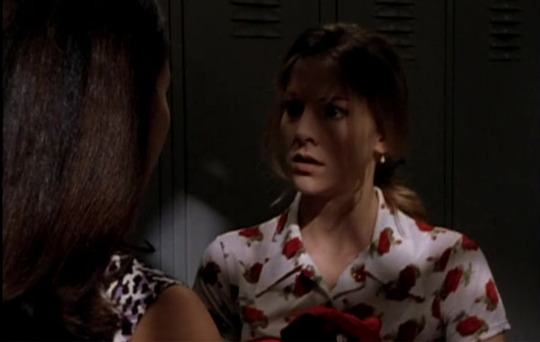






buffy season one imagery series: high school is hell
Buffy: This isn't this great power that she can control. It's something that was done to her. That *we* did to her. (1x11, Out of Mind, Out of Sight)
Willow: I'm not okay. I knew those guys. I go to that room every day. And when I walked in there, it... it wasn't our world anymore. They made it theirs. And they had fun. (1x12, Prophecy Girl)
#season one imagery series#btvs rewatch 2k20#btvs#buffy the vampire slayer#riffing off the amazing work of impalementation#thinking about how sunnydale high looks and feels so different in season one than the rest of the show#particularly how gothic and scary the school itself is#with the harsh shadows#big spaces making buffy look small#the fear factor of the school itself largely fades after season 2#but it's most prominent here#season 1 is so concerned with the school as a network with various nodes threatening to veer it offcourse into a horror film#both inside and outside the network#long post tw#long post
16 notes
·
View notes
Text
BtVS Rewatch: 1x10, Nightmares
continuing my weekly rewatch of buffy with my partner (his first time watching), we watched nightmares last week, immediately after The Puppet Show - while we initially planned to watch the show weekly, he enjoyed The Puppet Show so much that we watched three episodes in a row - TPS, Nightmares, and Out of Mind, Out of Sight (OOMOOS). While I have always thought of this episode as one of the best season one episodes, I ended it feeling a little bored and my partner felt more than a little confused about the mechanics. This episode seems to me to have an issue with growing pains: on one hand, it’s trying to be a Monster of the Week horror movie riff like the previous season one episodes - on the other hand, it’s attempting to be a character study with its focus on its principal characters’ nightmares, transitioning the show towards a more character-based mode of storytelling. The results are muddled and half-baked, but you can see the show attempting to be more, and do more with its characters. Even the theme of the episode - childhood nightmares and intergenerational encounters - seems to be inching towards a character focus, compelling the show to consider its characters more forcefully.
more thoughts on childhood, the role of the Slayer, and the show’s movement towards greatness:
What I did remember of this episode before going in is its middle section, where Buffy encounters her dad and you see her fall apart as he tells her she was the reason her parents broke up. On one hand, this is linked to her Slayerhood and her feelings of isolation and shame over it - this moment is an excellent character study in light of that, and an important gear shift for the character as we begin transitioning into season two. And yet, it’s absolutely mired in the plot of our nightmares coming to life, and so it becomes an archetypal scene for a child learning that their parents split because of them. When Buffy the character is played too much as Buffy-as-metaphor, she loses coherence and depth, and we risk losing that here too, as Buffy Summers fades into Buffy-the-kid.
And this episode is all about childhood! We have two children that centre the episode - Billy the kid who’s been beaten up by his coach, and The Anointed One, who The Master pontificated to at the start of the episode. They counterpoint each other, with the Anointed One’s tutelage from the Master mirroring Billy’s tutelage from Buffy later. Where Buffy approaches Billy as an equal, guiding him and respecting his agency, The Anointed One exists to be taught by the Master about the world of nightmares. Fittingly, the Anointed disappears by the time the Master emerges to kill Buffy.
The issue is, with the focus on childhood, the fears and nightmares that emerge are very much of childhood - Cordelia is dragged away to the chess club, Willow has to sing on stage, Xander goes to class in his underwear. These superficial nightmares of this episode ricochet off the MoTW’s focus on childhood, but end up being a middling character study. We already know Willow’s scared of the stage. We will learn next episode that Cordelia has much deeper fears of isolation and loneliness. Xander’s fear of being naked in class tells us nothing.
What it does do, though, is position Buffy as the one teen emerging into adulthood - her fears rapidly escalate and warp reality around them far more than the others’ do. Buffy’s exceptionalism is highlighted her, and her specific fears of being buried alive and being told that she caused her parents’ divorce position her as a liminal figure, trapped, but also moving, between the world of the adults and the world of the children. When the Master emerges to explain the world of nightmares to her, her previous role of teacher to Billy is contextualized, and her adolescence - caught between two worlds - is highlighted, where the Master is very much placed in the role of the old, the aged, the mature.
The nightmares of this episode do tell us something about the show, where it’s heading, and why Buffy Summers functions so well as a study of adolescence. The Slayer role gives her the responsibility and depth that sets her apart from other students, and highlight the isolation teens (and generally people) face, the sense that your own concerns and issues are the most pressing, apocalyptic, and world-changing. In this light, the superficiality of other characters’ nightmares are a given. At the same time though, it is a disservice to these wonderful characters who will eventually jostle with Buffy Summers for screentime and development, and it is their current subservience to her growth which renders some of the frustration of this episode.
Also, the episode is just… confusing? The Billy story is surprisingly hard to follow, as my partner pointed out. Why should we care about this kid? Why is his backstory so convoluted? It’s played as a mystery, but it’s not as intriguing or elegant as previous mysteries, and just seem slapped together to give us the character time this episode has. The show will begin to do these perfunctory plots better as the show goes on, but right now, it’s both weirdly simple and overly complicated. As morgue mentions, it’s a pretty missed opportunity - by straying away from the high school, the story risks losing the plot of the show’s original concept, and is just a much less interesting story for it. Not a great look!
5 notes
·
View notes
Text
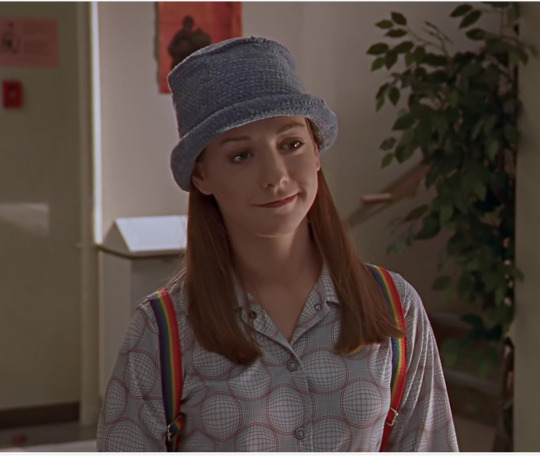
Imagine thinking Willow was written as straight in the early seasons of Buffy when she wears a rainbow backpack...wow...
#this is a joke#inca mummy girl#willow fashion#btvs rewatch 2k20#buffy the vampire slayer#willow rosenberg#what a baby gay
5 notes
·
View notes
Text
Btvs rewatch 2k19/2k20 (1x08, I Robot, You Jane)
Continuing my not-so-weekly rewatch of buffy with my partner, we just watched I Robot, You Jane… we actually watched Never Kill A Boy On The First Date, The Pack, and Angel a while ago and I do indeed have Thoughts written out in note form on my iPhone…but I have yet to put them into any coherent form so I might return to them at some point.
For now, I’m going to try to make sense of what is supposedly another contender for the worst episode of BtVS.
On transmediation and digital fears:
If there is anything to take away from this episode, it is its commentary on media and transmediation, fitting for the genre-bending, postmodern pastiche the show would evolve into. From the start, the show has been riffing on horror tropes and movies, but this is the first episode that actually explores what media is, does, and can be – these ideas will be explored with much more finesse and deftness in later seasons, with episodes like Once More With Feeling, Storyteller, Buffy vs Dracula, Restless, Superstar and I’m sure many others that I can’t think of right now. In doing so, this is arguably the first episode to look at itself, a self-awareness that will continue to define and shape the series in years to come. This is after all, the episode with the line: “Besides, I can just tell something's wrong. My spider sense is tingling . . . Pop culture reference, sorry.”
This is also one of the most widely reviled episodes – The Passion of the Nerd’s review only offers a drinking game for everything the show gets wrong about computers, it is widely critiqued for being a terrible Willow episode, morgue calls out its bizarre tonal shifts and boring monster, and criticallytouched comments on its absolute bungling of digital horror and its lack of subtlety with regards to those themes. Its last scene, however, is widely loved for the self-aware moment in which the Scooby gang commiserate over how they’ll never have a healthy relationship, which morgue refers to as a moment in which Buffy is placed firmly into the “post-modernist mode of self-aware 90s entertainment, and combined into one scene they come close to breaking the fourth wall and knowing they are characters in a TV show”.
This post-modern self-awareness pervades the episode though! The monster in this episode is essentially a transmedial monster, moving from interface to interface, attempting to become flesh again, moving from book to digital space to a robot body. It is a pity this episode is so clunky – this is a fascinating concept! A network monster! My partner called this proto-proto Black Mirror, and in today’s renewed moment of digital pessimism, it’s interesting how much this episode’s technophobia continues to resonate. Even the men controlled by Moloch seem to be the precursors to the Trio in season 6, who are now read as the precursors to contemporary incels.
The episode itself is intimately concerned with media – the thoroughline to this episode is the introduction of Jenny Calendar, a technopagan who spars with Giles over the promises and drawbacks of the digital age. Jenny argues that technology democratizes knowledge, evidentiated by her own participation in a technopagan online community, with magic no longer bound up in the musty books of a handful of white guys (her words!). Giles on the other hand, abhors the way this democratization loses the specific quality and texture of knowledge found in books, losing the unique “smell” books possess, stripped of sensory and material pleasure. The show takes a few potshots at itself as a TV show in the process – at one point, Jenny refers to TV as “the idiot box” as opposed to the “good box” that is computers; at another point, Jenny tells Giles he’s been watching too many movies.
The unbinding and democratization of knowledge is reflected in the actual unbinding of Moloch, and their inability to return him to a book, which today feels like a commentary on how the Internet unwittingly creates platforms for ancient evils to re-emerge and take new forms in a Hydra-like manner. As noted earlier, this calls to mind the creation of the incel ideology and newfound fascisms that have taken root in online spaces, recalling the fascisms of the 1920’s. Moloch himself, as a demon feeding on love, is an ideological monster, making him particularly apt for a digital monstrosity that creates cults and followers. While the intended metaphor was about the dangers of online dating, the contemporary resonance of this episode is far more about the dangers of online cults, which I find a far more interesting story to chew on.
Another thing this episodes hints at is the emergence of fake news – throughout the episode, background characters are overheard noticing odd things about the digital sphere, like a nurse saying someone’s records had been changed. It’s not a particularly interesting development, but it is an interesting historical moment to think over. With the introduction of new information technologies, anxieties over fake information always emerge, which also happened with the introduction of the printing press in 1440. Amusingly, Moloch is binded before the printing press, during the time in which each book was actually individually printed and bound, speaking to Giles’ taste for the unique and specific.
The episode ends when Moloch is finally bound to a robot body, making him killable – the corollary is that if he had remained in the Internet, it would have been impossible for a Slayer to defeat him. True to form, the show will struggle to depict these kinds of networked monsters that exist beyond a specific form, and will only really return to this concept with The First Evil in season 7 (and arguably The First Slayer in Restless). These monsters, which cannot be fought in hand-to-hand combat, provoke a unique conundrum for the show to depict satisfyingly. Moloch is a far more deadly creature on the Internet than he is in a robot body.
Am I overthinking this episode? Probably! But it is an interesting historical artefact (more than it is an interesting Buffy episode), and in the context of a show concerned with media and postmodernism, it has a surprising amount of insights and leads to follow. It’s a pretty meh showing for the characters and dialogue, and definitely nowhere near as good as the show will get, but it’s not as terrible as people make it out to be!
A few other notes:
This is one of the only early episodes to play on surveillance themes – these themes will emerge again in season 4 and 6, as detailed in impalementation’s imagery series of the show.
Morgue’s review argues that one of the reasons this episode doesn’t work is that it ventures too far out beyond the high school scale – yet what I really like about this episode upon rewatch is how creepy it makes the computer lab and the girls’ locker room – these are very specific places to make scary, and goes beyond just the creepy classroom aesthetic that defines some of the more high school Buffy episodes! The specificity of making the computer room scary really appeals to me.

#btvs rewatch 2k19#btvs rewatch 2k20#buffy the vampire sla#buffy the vampire slayer rewatch#buffy the vampire slayer meta#btvs meta#i robot you jane#btvs 1x08#btvs
2 notes
·
View notes
Text
Bonus:

0 notes